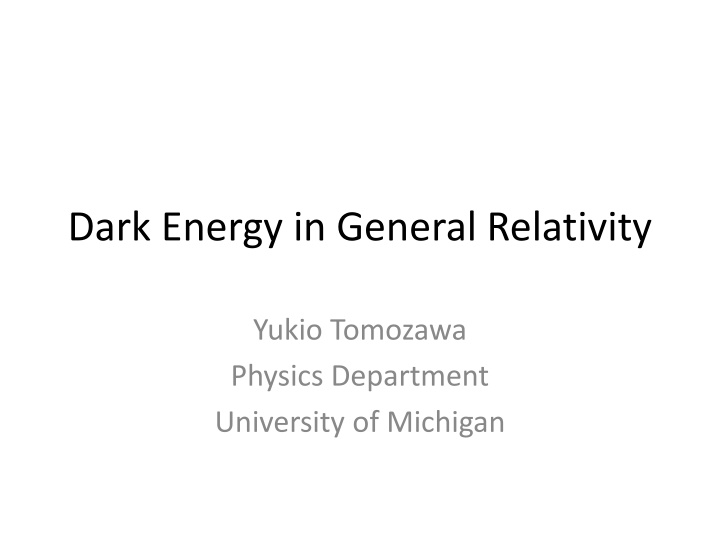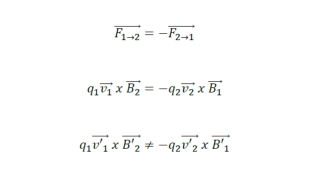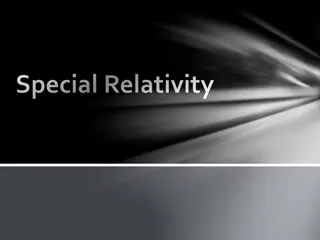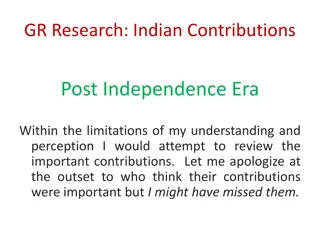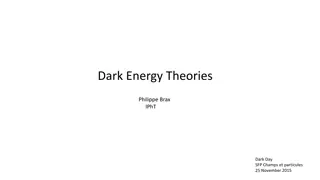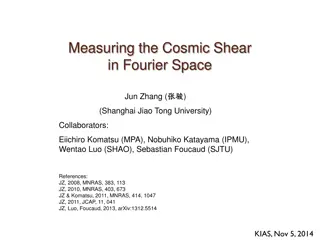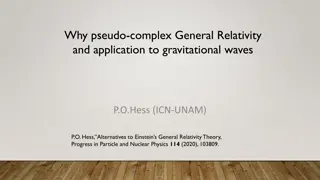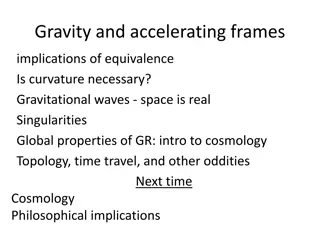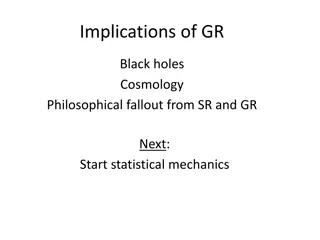Insights into Dark Energy and General Relativity by Yukio Tomozawa at University of Michigan
Exploration of dark energy in the context of General Relativity, covering topics such as the acceleration of universe expansion, experimental tests of GR, nature of black holes, masses in BH mergers, coordinate transformations, and the end of universe expansion.
Uploaded on Sep 25, 2024 | 1 Views
Download Presentation

Please find below an Image/Link to download the presentation.
The content on the website is provided AS IS for your information and personal use only. It may not be sold, licensed, or shared on other websites without obtaining consent from the author.If you encounter any issues during the download, it is possible that the publisher has removed the file from their server.
You are allowed to download the files provided on this website for personal or commercial use, subject to the condition that they are used lawfully. All files are the property of their respective owners.
The content on the website is provided AS IS for your information and personal use only. It may not be sold, licensed, or shared on other websites without obtaining consent from the author.
E N D
Presentation Transcript
Dark Energy in General Relativity Yukio Tomozawa Physics Department University of Michigan
Contents Acceleration of Universe expansion, dark energy Experimental test of General Relativity (GR) The Physical Metric (PM) Nature of black hole (BH), extended horizon Masses of BH merger in GW150914 Coordinate transformation from PM to FRW (Friedmann-Robertson-Walker) metric Inside-acceleration, Outside-deceleration The end of the universe expansion
Acceleration of Universe expansion The universe expansion is accelerated. Physics Nobel Prizes are given in 2011.
Acceleration http://i234.photobucket.com/albums/ee66/neutralino/PerlmutterSchmidtfig4.gif
Cosmological constant, Acceleration always. a( ): expansion factor [(da( )/d )/a( )]^2=8 G /3 + /3, =constant For =0, a( ) = A exp (( /3)^1/2 * ) Accelerating expansion!! a ( ) > 0
Experimental test of GR Time delay experiment of Solar system I. Shapiro et al, Bertotti et al. t = (r_s /c) ln (r/b) fits the data well (1/10^5 accuracy), where b is the impact parameter and r_s is the Schwarzschild radius (SR hereafter). r_s = 2Gm/c^2 The Schwarzschild metric of GR gives the prediction (See Weinberg s Gravitation, p.202) t = (r_s /c) [ln (r/b) + *((r-b)/(r+b))^1/2] This does not fit the data.
Lesson in GR The Schwarzschild metric is the exact solution of the Einstein equation, but it does not fit the experimental data. ds^2=exp(a(r))*dt^2 exp(b(r))*dr^2 r^2*exp(c(r)*d If exp(a(r)=exp(c(r)), one gets the correct formula for time delay experiment, t=(r_s/c) * ln (r/b).
The physical metric (PM) exp(a(r)) = exp(c(r)) = Schwarzschild metric, r = r * ^1/2 1-r_s/(r* ^1/2) = Solving for r_s/r, one gets r_s/r = ^1/2 * (1 ) This terminates at R = (3*3^1/2)/2 r_s = 2.60 r_s This gives the size of BH, called the extended horizon. exp(b(r)) = (d(r* ^1/2)/dr)^2/ = (2 /(3 -1))^2
PM(Inside solution) Inside the extended horizon, using the internal solution of the Schwarzschild metric one gets D (r_s/r) = ^1/2 (A 1) Connecting the inside and outside solutions at the extended horizon, R, one gets A = 2D + 3 The choice of D > 0, A > 3 makes all the metric functions positive definite. exp(b(r)) = A*(2 /(3A -1))^2 The inside solution is repulsive. (See the graph in the next page. This is a new feature!)
Gravitational redshift at R On the surface of BH, i. e. at r = R, g_00(R) = 1/3. Then the gravitational redshift at R is 1 + z = 1/(g_00(R))^1/2 =3^1/2 = 1.732
PM with constant density, [inside] For r < R = 2.60 r_s, = 1/ (B+(8 G r^2)/3)) exp(b(r)) = B ^2 This is a repulsive gravity. Connecting at r = R, one gets B = 3 2/3 *3^1/2 = 2.615
Nature of BH and Neutron Stars The radius is 2.60 times SR. This is a surprise! The gravitational red shift at R is 1+z = 1/ ^1/2 = 3^1/2 = 1.732 The temperature of BH and NS is very high. T d /dr outside of R positive temperature at R infinity inside of R negative temperature (higher than any positive temperature) Boltzman Probability exp(-E/kT) For T<0, high E state is more probable.
Black hole merger in GW150914 http://www.ligo.org/science/Publication-GW150914/images/fig-3.png
Black hole masses in GW150914 The numerical simulation indicates the masses of black hole merger to be M_1 = 29 (+4, -4) M_ M_2 = 36 (+5, -4) M_ M_f = 62 (+4, -4)M_ These must be changed to (divided by 2.60), since the size of black hole is increased by 2.60 M_1 = 11.2 M_ M_2 = 13.8 M_ M_f = 23.8 M_
Away from the Merger Contact The change of energy by GW emission, -dE/dt = F (32G/5c^5)*(m1 m2 /(m1+m2))^2 * r^4 * ^6, where F= (2.60)^2 * (1+z)^2 is the enhancement factor by the size of BH and the gravitational red shift, 1+z = This factor F is good enough to fit the data by smaller masses, m1 = 13.8 and m2 = 11.2 SM. 3 =1.732.
Coordinate transformation from PM to FRW (Friedman- Robertson- Walker) FRW ds^2=d ^2 a( )^2*(d ^2/(1-k ^2) + ^2*d ), where k =0, 1. PM ds^2 = *dt^2 exp(b(r))*dr^2 r^2* *d r < R, = 1/(B + (8 G r^2)/3) exp(b(r)) = B ^2, B=2.615 r > R, r_s/r = ^1/2 * (1 ) exp(b(r)) = (2 /(3 -1))^2
Coordinate transformation [1] t = t( , ), r = r( , ) dt = ( t/ )d + ( t/ )d dr = ( r/ )d + ( r/ )d a( )* = r* ^1/2 ( t/ )^2 exp(b(r))*( r/ )^2 = 1 exp(b(r))*( r/ )^2 *( t/ )^2 = a( )^2/(1- k ^2) *( t/ ) ( t/ ) exp(b(r))( r/ ) ( r/ ) = 0
Coordinate transformation [2] Eliminating t/ and t/ , and using the explicit formulae for and exp(b(r)), one gets (a ( ) )^2 = 1- k ^2 B/(B + (8 G r^2)/3) for r < R, and (a ( ) )^2 = 1 - k ^2 for r > R The right hand sides of the both equations are positive definite for k < 0 or k=0 or for small value of .
Coordinate transformation [3] Differentiating the equations in the previous page wrt , one gets a ( ) = (8 G r/3)/(B + (8 G r^2)/3)^1/2 (1) for r < R, and a ( ) = - (1 )/(2*r* * ^1/2) (2) for r > R a ( ) in Eq. (1) is positive and that in Eq. (2) is negative. These are the results from d /dr < 0 for r < R (repulsive) and d /dr > 0 for r > R (attractive).
Dark energy by PM By coordinate transformation from PM to FRW metric, the author has shown that the universe expansion is accelerated inside the extended horizon (R) and decelerated outside R. This is the result from the nature of the gravity being repulsive/attractive for inside/outside of R in PM. The difference from Cosmological Constant is clear, since the latter gives acceleration everywhere.
The end of the universe expansion [1] For simplicity, let us assume k = 0. (The observation is consistent with this assumption.) Then, a ( )* = (1 )^1/2 for r>R. Since (1 )^1/2 = (r_s/r ^1/2)^1/2 = ( r_s/a( ) )^1/2, one gets a( )^1/2 * a ( ) = (r_s/ ^3)^1/2 and it s solution is a( ) = (H( )* + K( ))^2/3, where H( ) = (3/2)*(r_s/ ^3)^1/2, and K( ) is an integration constant.
The end of the universe expansion [2] For r > R, a( ) = (H( )* + K( ))^2/3 This means that although outside the extended horizon the universe expansion is decelerated, the expansion reaches at the infinite distance.
The most important comment The property of BH in PM is entirely different from that in the Schwarzschild metric. Almost everything based on the latter is wrong. One has to review all the observable properties of BH and Neutron Stars (Compact Objects) based on the new metric (PM).
